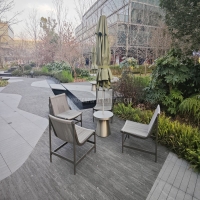Welcome to the website for landscape facilities products and knowledge.
What are the differences between hand-woven and machine-woven materials in landscape chair construction?
When selecting landscape chairs, the weaving method significantly impacts aesthetics, durability, and sustainability. Hand-woven chairs typically use natural materials like rattan, bamboo, or water hyacinth, showcasing unique artisanal patterns with slight variations that add character. Each piece requires 8-15 hours of skilled craftsmanship, resulting in higher costs but exceptional individuality.
Machine-woven alternatives employ synthetic fibers (HDPE, polyester) or processed natural materials for uniform precision. Automated looms produce consistent patterns at 10-20 chairs per hour, offering affordability and weather resistance. The tight, standardized weaves resist moisture better but lack organic texture.
Key differences include:
1. Durability: Hand-woven chairs last 5-7 years with proper care, while machine-woven versions endure 10+ years due to synthetic UV treatments
2. Eco-Impact: Natural hand-woven materials biodegrade, whereas machine-woven plastics require recycling
3. Comfort: Hand-weaving allows breathable gaps, while machine precision creates firmer seating surfaces
4. Maintenance: Machine-woven cleans easily with hose-downs; hand-woven needs gentle brushing
For high-end resorts seeking artisanal charm, hand-woven chairs create visual warmth. Commercial spaces prioritizing longevity often choose machine-woven options. Recent hybrid designs combine hand-finished details with machine-woven bases for balanced appeal.
Related search:

Recommendation
Metal structure rattan chair without armrests for single person, with woven seat and backrest.